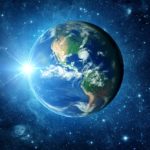The earth first formed around 4.5 billion years ago from a huge cloud of dust and gas. This nebula, as it was called, gradually collapsed in on itself under the force of its own gravity. This collapse eventually led to the formation of our sun and all the planets in our solar system, including Earth.
Initially, our planet was just a huge ball of magma, or melted rock. Gradually, though, it cooled down and formed a hard crust. At the same time, the atmosphere on Earth began to change. Originally, it is believed that methane gas dominated the air. However, over time, living things gradually changed the makeup of the atmosphere until today it is comprised mostly of nitrogen and oxygen. With trace amounts of other gasses.
As the Earth cooled it began to rain down heavily and eventually formed our oceans. Scientists believe that it may have rained for more than 1,000 years.
It is thought that the first signs of life emerged in these oceans, slowly adapting to their new environment. Eventually, these living things left the ocean and began to colonize the land.
There was also a period in Earth’s early history, known as the great bombardment, where asteroids hit our planet’s surface quite frequently. However, we have very little evidence of this event today on Earth because the geological forces have erased it. The moon still has impact craters that offer up clues to this time period, though.
Since its formation, the Earth has experienced periods of great change. Including times knows as snowball earths which were when the planet was covered in ice. But it has also experienced periods of stability and growth, like we are currently experiencing.
The continents have also constantly moved and changed through the process of plate tectonics. And mountain chains have formed, only to later erode and disappear.
Who knows what the future will hold for our planet. But one thing is for sure, it has an amazing history that continues to fascinate us.






